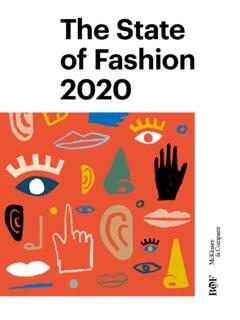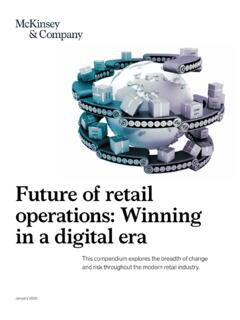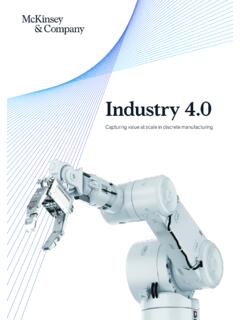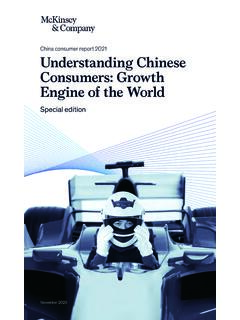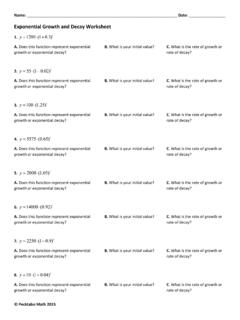Transcription of Automotive software and electronics 2030 - McKinsey & …
1 Automotive software and electronics 2030 Mapping the sector s future landscapeAuthorsOndrej Burkacky, Munich Johannes Deichmann, Stuttgart Jan Paul Stein, MunichAcknowledgementsThis study was conducted by McKinsey & Company, Inc. We wish to express our appreciation and gratitude to GSA and its members for their continued support and valuable contributions. Automotive software and electronics 2030 Mapping the sector s future landscapeTable of contentsIntroduction and key insights 61. software and electronics will outgrow the Automotive market The software and electronics architecture in vehicles will see a major evolution ACES trends and the architecture evolution will result in significant growth in the Automotive electronics and software market 122. Key drivers of the Automotive sector s changing landscape software : the global Automotive software market will show dynamic growth Electronic control units/domain control units: convergence of electronic control units will open up a new market for domain controllers Sensors: autonomous driving will be the primary trigger for sensor demand Power electronics and harnesses: transition to EVs will enable the formation of a new market 263.
2 Disruptive trends along the industry s long-established value chains New technologies are breaking up the power dynamic of traditional relationships between OEMs and tier-1 suppliers Separation of hardware and software is leading to new sourcing models New companies are entering the playing field in nontraditional and Automotive areas New partnerships and cooperation models are emerging primarily for software - and electronics -related topics 344. Building blocks for mapping your Automotive software and electronics strategy Strategic considerations for each Automotive player archetype First steps for all players in navigating the changing landscape 38 Appendix 39 Key aspects of the market models 39 List of abbreviations 41 Definitions 42 Important notice 43 Contacts and authors 445 Automotive software and electronics 2030 Introduction and key insights6 Automotive software and electronics 2030 Autonomous driving (AD), connected vehicles, electrification of the powertrain, and shared mobility (ACES) are mutually reinforcing developments in the Automotive , they are not only disrupting the Automotive value chain and impacting all stake-holders involved but are also a significant driver of the expected 7 percent compound annual growth rate (CAGR)
3 In the Automotive software (SW) and electrical and electronic components (E/E) market, , from USD 238 billion to USD 469 billion, between 2020 and 2030. At this rate, the SW and E/E market is expected to vastly outpace growth in the overall Automotive market, which is estimated to grow at 3 percent CAGR in the same time span. As a consequence, SW and electronics have become the focus of most Automotive companies and their executives. In this context and based on our extensive research and analyses (Text box 1), we offer a perspective on three key questions: What are the specific trends and drivers of the Automotive sector s SW and E/E growth dynamics and the changing landscape towards 2030? How are these drivers going to affect the Automotive industry s long-established value chains? How can players in and outside of the industry optimally prepare for the upcoming market developments?In the following three paragraphs, we provide a short answer to these questions while the remainder of this report will go into insights of this report were generated based on closely linked qualitative and quantitative research.
4 For the qualitative insights, we held interviews with executives in the Automotive industry and combined them with the knowledge of internal key experts within our Automotive practice to build a holistic view on how ACES trends and additional drivers will influence the Automotive SW and E/E our quantitative market insights, we built bottom-up market models for each of the core components within the Automotive SW and E/E market: SW development, integration, verification, and validation Electronic control units (ECUs)/domain control units (DCUs) Sensors Power electronics Other components (harnesses, controls, switches, displays).At the highest level, these models (excluding SW) calculate the market size following the same logic. Market size is the product of the number of a certain component per vehicle, its average selling price (ASP), and the number of vehicles produced in a given year. To achieve the proper granularity of each model, we distinguish the key Automotive domains ( , advanced driver assistance systems (ADAS), body, infotainment) as well as characteristics such as vehicle segment, original equipment manufacturer (OEM) type, or SAE AV level.
5 The number of vehicles produced each year is provided by a separate model in which we incorporate data from latest McKinsey insights. The size of the Automotive SW market is calculated based on the workforce across the supply chain involved in SW topics and the number of vehicle platforms and variants across OEMs and tiers and their change over details on the market models and their derivation are provided in the box 1 How we derive insights for this report 7 Automotive software and electronics 2030 The SW and E/E components market will grow rapidly with significant segment-level variation driven by disparate impact of the ACES trends The move towards a more centralized SW and E/E architecture is an overall trend and a key driver of the market s expected growth (7 percent CAGR) by 2030. Significant variation is expected across the market s various segments. Power electronics is expected to occupy the high end of the market s growth at 15 percent CAGR. growth in the SW and sensors segments, expected to be at 9 and 8 percent, respectively, will be fueled by AD.
6 The ECUs/DCUs segment will continue to hold the largest share of the market, but growth here is likely to be relatively low, at 5 percent. While ECUs/DCUs will be used increasingly in the application of AD, price decreases from efficiency gains will counter-balance growth in the segment. Electric vehicle (EV) platforms will be a new market for high-voltage (HV) harnesses, while the demand for low-voltage (LV) harnesses is expected to shrink, resulting in the harness segment growing at the slowest rate. A separation of hardware (HW) and SW would fundamentally change the dynamics of the Automotive industry s player and value landscapeThe days of OEMs comprehensively defining specifications and suppliers delivering on them may be nearing an end. Neither OEMs nor traditional suppliers are in a position to fully define the technology requirements of new systems. Codevelopment between OEMs and suppliers is expected to become not just prevalent but necessary. In addition, tech-native companies are expected to more boldly enter the space.
7 This will be made easier as HW and SW sourcing become more separate. This separation would break up established value pools, reducing barriers to entry. For OEMs, the separation would also make both sourcing more competitive and scaling less complex and allow for a standardized platform for application SW while maintaining competition on the HW archetype-specific and cross-player strategies can position companies for success in the future landscapeThe set of strategic actions for OEMs includes a plan to keep the cost of ever-growing HW and SW development under control and establish a more agile cross-functional development organization. Cross-functionality would benefit tier-1 suppliers, too, as would actively partnering with OEMs to define their E/E architecture. Tier-2 suppliers will want to further specialize and scale within an attractive niche to thrive even as many components become commodity. All players will benefit from building their SW delivery and E/E architecture capabilities, embracing latest technology innovation (including UI, UX, analytics), and abandoning absolutistic notions of competition while analyzing the benefits of a partnership within an emerging software and electronics 2030In the next decade, the Automotive industry will face a magnitude of change that has not been seen in a century.
8 This change will be driven primarily by four mutually reinforcing trends, , autonomous, connected, electric, and shared (ACES) vehicles. These will result in different user behaviors and mobility preferences, shifting value pools, innovative business models, and new entrants into Automotive . All of these trends are enabled by the advancement of technology in electronics and SW and thus have a substantial impact on the Automotive electronics and SW market. 1. software and electronics will outgrow the Automotive market The software and electronics architecture in vehicles will see a major evolutionAs shown in Exhibit 1, the overall trend is a transition from a decentralized architecture (components connected by a central gateway in the 3rd generation of E/E architectures), in which functions are running on dedicated ECUs with high SW-to-HW integration, towards more centralized systems with dedicated domain controllers (4th generation). Finally, the architecture is expected to evolve into virtual domains (5th generation), in which one control unit runs functions or (micro-)services of different domains ( , infotainment and body control).
9 The centralization will go along with a separation of HW and SW, leading to vehicle systems being built as a layered architecture with clear abstraction points at operating system (OS) and middleware layers. While this evolution will occur across domains over time, infotainment and driving assistance are expected to be the forerunners, as areas of high performance and/or low safety or latency criticality are easier and/or more beneficial to transform. The architecture evolution will impact multiple component markets: DCUs will become a new market segment with high-performance computing units being deployed in vehicles, especially for ADAS, and with higher autonomous vehicle (AV) levels, , AD. ECUs will no longer be fully tied to the sourcing/development of SW functions. The change in business model is made possible by the separation of HW and SW. Automotive sensors, as a market, will be distinguished between smart sensors, which have a high degree of (pre-)processing capabilities versus raw sensors, which send data into a central DCU.
10 Sensors, harnesses, ECUs, and other HW components will become increasingly standardized and commoditized with the transition towards SW-defined functions, , functionality will be realized through SW instead of additional HW ( , ADAS functions enabled on-demand based on a standardized set of sensors).10 Automotive software and electronics 2030 Exhibit 1 The E/E architecture is evolving from independent, function-speci c ECUs towards a centralized architectureGenerationMain features High-level architectureDomain centralized Central domain controller Ability to handle more complex functions Consolidation of functions (cost optimization) Collaboration of ECUs within one domain Domains: body/comfort, chassis, powertrain, and infotainment 3-4 independent networks Limited communication between domains Independent ECUs Isolated functions Each function has its ECU (1:1 connection)Vehicle centralized Virtual domain Limited dedicated HW Ethernet backbone Complex functions, high performance computingE/E architectureDistributed Stronger collaboration via central gateway Cross-functional connection Ability to handle complex functions, , adaptive cruise controlSOURCE.


